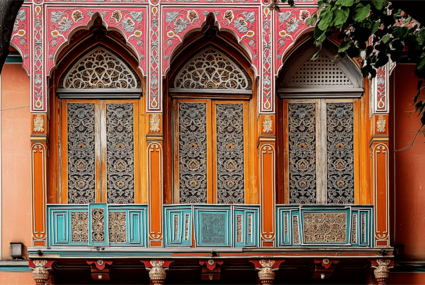Architecture of Tamiran
| This article is part of a series on the |
| Imperial States |
|---|
 |
| Politics |
|
Constituent States
|
| Languages |
|
Official languages
Regional languages
Minority languages
|
| Religions |
| Historical events |
The architecture of Tamiran encompasses the diverse styles found in its constituent countries, spanning both contemporary and historical periods, along with the legacy of past empires in the Tarkhan region, notably the Baysanid Khanate, the Great Horde, and the Koman mizarates. Given the federation's vast expanse, the term typically applies to structures within its current borders, yet it also embraces edifices beyond current borders that exhibit distinct architectural influences of its many empires.
The vernacular architecture of Tamiran widely differs in styles, Pre-Asharid buildings were often made of adobe-derived materials, showcasing extensive brickwork in inland settlements. Masonry construction and woodwork are more predominant around the Melkanchuta coast, where timber is less scarce. Tilework has always remained a consistent trait in both Pre-Asharid edifices and constructions of later periods. The gradual migration of Kalkali peoples to the Tarkhan mountains in the 12th century onwards sparked an increase in monumental masonry construction which was later magnified by the Great Horde, as Kalkali peoples started settling in large cities and abandoned their nomadic lifestyle.
Early forms of traditional architecture in Tamiran largely derive from both classical and late Ohanian architecture, with considerable foreign influences from Parshita and Soltenna through historical trading roads.
Pre-Sayanic architecture and the Baysanids
Pre-Sayanic architecture in Tamiran mainly consists of early styles developed in the early 1st to 6th century CE by the Mishar Baysanids. Between 500 BCE and the 5th century CE, the coastal regions came to be largely part of the Mamikian Empire, marking a time when Ohanian influence was at its highest. Today, most Pre-Sayanic edifices can be found in the Yunesh, Tokhum and Kumar provinces of the Ashar Princely State, Komania, with most extant Baysanid buildings found inland around Samadar and Shahdar.
Pre-Sayanic architecture in Torosha and Araman is heavily marked by the abundant construction of monumental masonry edifices from the Kaatian Empire (57 BCE - 566 CE). Kaatian styles varied heavily, however, notable characteristics included the use of decorated pillars, often painted in red, and pyramidal parapets along the flank of low-level roofs. In contrast, the coastal regions of Araman are noted to be devoid of such buildings, where instead, the use of crude masonry is often paired with the use of timber for the upper sections of walls and flat wooden roofs, blending traditional masonry techniques with timber framing and carved wood details for the upper part of the structure, a style and construction technique commonly used by the Yeri people between the 4th and 11th centuries.
Baysanid period
Traditional Yeri houses
Between the 1st and 5th centuries, the gradual expansion of the Mamikian Empire forced the migration of the Yeri people eastwards along the Melkanchuta coast. This demographic change sparked a transition towards a more sedentary lifestyle as Yeri tribes fell under the tributary system of the Mishar Khanates. This abrupt demographical change led to the construction of more "crude" structures as they kept a decentralised system of governing heavily reliant on grazing, and livestock farming. This led to the development of the traditional Yeri house, where crude masonry is utilised for the construction of houses on the ground level while employing timber on the upper section of houses. This development allowed for the raising of house cattle on the lower levels while keeping the living spaces out of reach on the upper levels of the house. This vernacular style became widely popular along the coast of Araman and was widely adopted by later Kalkali peoples migrating to the region. The extensive usage of timber was enabled thanks to the milder climate of the Melkanchuta coast, where lush forests can be found in abundance.
- Aramani countryside.png
Barn houses are a common sight in the Aramani countryside.
- Old Yeri street.png
An old street with traditional Yeri houses.
- Yeri balconies.png
Some Yeri houses make extensive use of balconies, allowing larger living spaces.
Ohanian influences
Marameh city-states
Osheshdi styles
Early Sayanic architecture
Uhimids
Tameng Hojanate
Mishar styles
Kothlenic influences
Mujerim
Asharid period
Sayanic architecture
Sayanic architecture is a collective term for Sayanic architectural styles used largely in religious and public buildings. These styles follow the Sayanic design principles laid out by the First Enlighteners in the 6th century CE. It encompasses styles developed between the 6th to 19th centuries throughout Vaniua and abroad. Large empires such as the Great Horde made extensive use of Sayanic architecture as a form of power projection, erecting countless monumental buildings often contrasting pre-Asharid edifices. Today, a large variety of sayanic styles can be observed in Tamiran, most prominently, these include buildings in the Hozara, Teskhaba, Sahyarkhaba, and Dekhaba styles. But also many buildings in pre-Asharid styles.
Dekhaba style
Hozara style
Sahyarkhaba style
Teskhaba style
Foreign influences and local styles
Warring period
Shanvani style
In the aftermath of the defeat of Prince Tamarkhan in the Battle of Samadar in 1659, Tamarkhan seized control of the city of Shanvan, laying the foundations for the Shanvan Mizarate in 1680. This defeat precipitated a significant exodus of Tamarkhan-aligned nobility, ushering in a new group of nobles along with their Samadari cultural practices into Shanvan, reshaping the social and political landscape of the city. These developments resulted in the culmination of new syncretic architectural trends, mainly a combination of Sayanic styles from Samadar with local styles of architecture characterised by the use of white stone and woodworking. The scarcity of traditional glazed tile artisans in this coastal city led to an innovative blend of materials and designs that gave birth to the unique characteristics of the Shavani style, named after the city itself.
While under heavy embargo from the neighbouring Samadar Mizarate, early forms of the Shavani style were heavily promoted by Tamarkhan, largely as a means of reducing material shortages and accommodating efficient housing. The replacement of glazed tiles with woodwork and conventional tilework meant that buildings could be completed at a faster rate and became widely adopted by the local population. These developments in the vernacular style were made more prominent through the commission of many city landmarks.
The Shavani style is characterised by the abstract patterns and motifs inherent in the Hozara style, with significant divergence from the conventional use of glazed tilework, substituting it with intricate, detailed woodwork or vibrant colour palettes, often adorned with organic, floral motifs. The subtlety of these adaptations showcases a change in societal customs and reflects the immense influence that the classical Asharid architecture came to have on local vernacular styles.
One of the defining features of the Shavani style is the adoption of Bakhe roofs, a design element commonly seen in both Hozara and Shankhaba architectural styles. These elongated, high-pitched roofs, shaped to withstand the maritime climate, serve both a functional and aesthetic purpose, underscoring the adaptive ingenuity of the Shavani style. Another characteristic of the Shavani style is its unique treatment of wooden balconies. These spaces, designed to optimise the limited urban footprint of Shanvan, came to be widely used as a means of ventilation, as these balconies were often designed with latticework for less intrusion, catching wind from the Melkanchuta Sea and enabling passive cooling. Later on, wooden balconies came to be used as an indication of one's social status.
The Uskhazur Palace, built in the mid-1700s, is a prime example of the Shavani architectural style.





